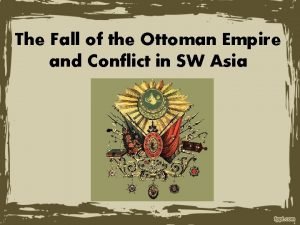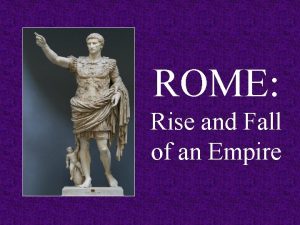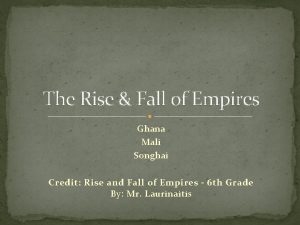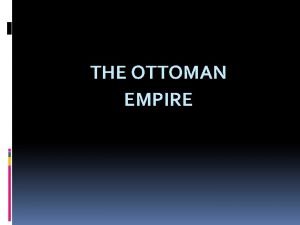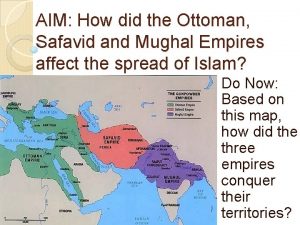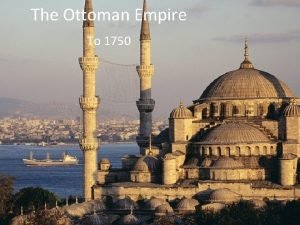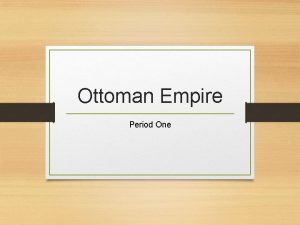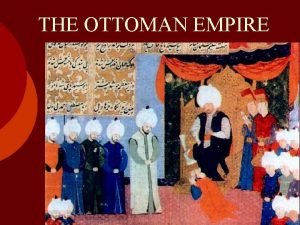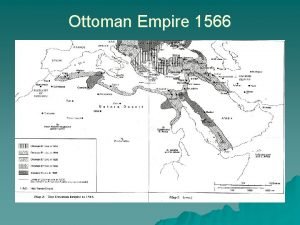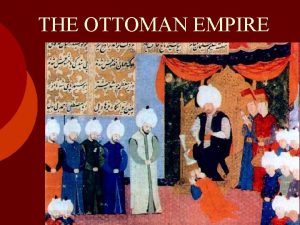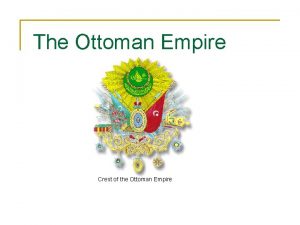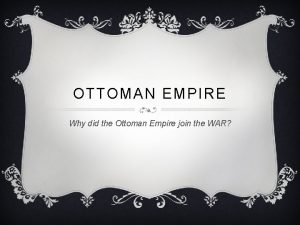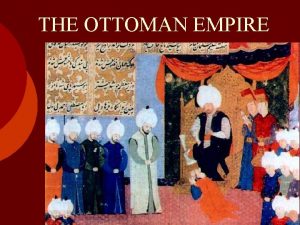The Ottoman Empire THE RISE AND FALL Ottoman












- Slides: 12

The Ottoman Empire THE RISE AND FALL

Ottoman Empire (1301 -1922) The Ottoman Empire was the one of the largest and longest lasting Empires in history. It was an empire inspired and sustained by Islam, and Islamic institutions. It replaced the Byzantine Empire as the major power in the Eastern Mediterranean.

Height of Power The Ottoman Empire reached its height under Suleiman the Magnificent (reigned 1520 -66), when it expanded to cover the Balkans and Hungary, and reached the gates of Vienna. At its peak it included: Much of North Africa Eastern Europe Most of the Middle East (Southwest Asia)

Rise of the Ottoman Empire Why was the Ottoman Empire so successful? Highly centralized: Power was always transferred to a single person, and not split between rival princes The Ottoman Empire was successfully ruled by a single family for 7 centuries. State-run education system Religion was incorporated in the state structure, and the Sultan was regarded as "the protector of Islam". State-run judicial system Ruthless in dealing with local leaders Created alliances across political and racial groups United by Islamic ideology

Rise of the Ottoman Empire (continued) Highly pragmatic, taking the best ideas from other cultures and making them their own Encouraged loyalty from other faith groups Private power and wealth were controlled Very strong military Strong slave-based army (The Janissaries) Expert in developing gunpowder as a military tool

Military Strength To consolidate their Empire the Ottoman Sultans formed groups of fanatical fighters - the orders of the Janissaries, a crack infantry group of slaves and Christian and converts to Islam. The Ottomans inflicted a series of defeats on the declining Christian Byzantine Empire and then quickly expanded

Constantinople was the heart of the Byzantine Empire. It became the capital of the Ottoman Empire when it was conquered in 1453 by the Ottoman Sultan Mehmet II Mehmet renamed Constantinople Istanbul – the 'city of Islam' - and set about rebuilding it, both physically and politically, as his capital.

The Capture of Constantinople The capture of Constantinople ended the Byzantine Empire after 1100 years. The effect of this on Christian Europe was enormous. One unexpected effect was that many scholars fled from the new empire and went to Italy, where they were influential in sparking off the Renaissance, and increasing trade with the east. Although the Pope demanded a crusade to recapture Istanbul from the Muslims, the Christian nations failed to produce an army for him, and no attempt to retake the city was made. The Muslim dominance of the trading center of the former Constantinople increased the pressure on Western nations to find new ways to the East by going westwards. This eventually led to the expeditions of Columbus, Magellan, and Drake.

Economics of the Ottoman Empire Istanbul became not only a political and military capital, but because of its position at the junction of Europe, Africa, and Asia, one of the great trade centers of the world. Some of the later Ottoman conquests were clearly intended to give them control of other trade routes. Among the goods traded were: Silk and other cloth Musk Rhubarb Porcelain from China Spices such as pepper Dyestuffs such as indigo

The Decline of the Empire The power of the empire was waning by 1683 when the second and last attempt was made to conquer Vienna. It failed. Without the conquest of Europe and the acquisition of significant new wealth the Empire lost momentum and went into a slow decline.

Decline of the Empire Causes of the Decline: • The European powers wanted to expand • Economic problems o Competition from trade from the Americas o Competition from cheap products from India and the Far East o Development of other trade routes o Rising unemployment within the Empire • Ottoman Empire became less centralized, and central control weakened • Sultans being less severe in maintaining rigorous standards of integrity in the administration of the Empire • Sultans becoming less sensitive to public opinion

The End of the Empire The Ottoman Empire allied with Germany and the Central Powers in World War I seeking to regain legitimacy and territory However, when Germany was defeated, the Ottoman Empire was largely dissolved by the Allied powers (mostly United Kingdom and France) The empire officially ended on the 1 st November 1922, when the Ottoman sultanate was abolished and Turkey was declared a republic.
 Richard nixon tricky dicky
Richard nixon tricky dicky What did the ottoman empire turn into
What did the ottoman empire turn into Ancient rome: the rise and fall of an empire cast
Ancient rome: the rise and fall of an empire cast Rome rise and fall of an empire
Rome rise and fall of an empire Rise and fall of ghana empire
Rise and fall of ghana empire The ottoman empire grew and expanded after it conquered the
The ottoman empire grew and expanded after it conquered the Ottoman safavid and mughal empire map
Ottoman safavid and mughal empire map Ottoman safavid and mughal empire map
Ottoman safavid and mughal empire map Ottoman safavid and mughal empire map
Ottoman safavid and mughal empire map Sheep become lions
Sheep become lions Raise and rise again until lambs become lions
Raise and rise again until lambs become lions Rise and rise again until lambs become lions origin
Rise and rise again until lambs become lions origin Ottoman empire 1815
Ottoman empire 1815

